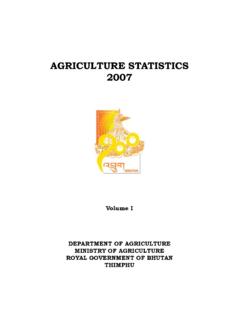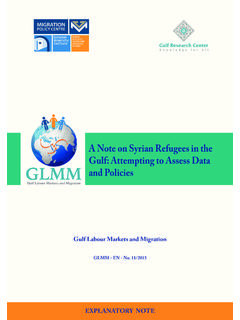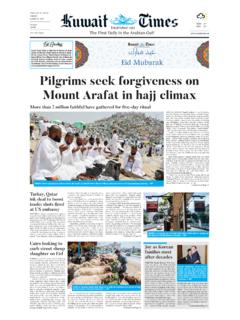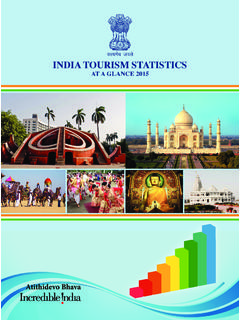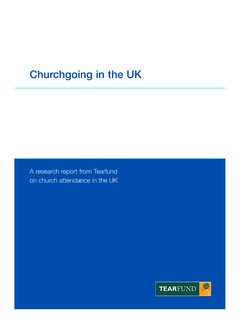Transcription of ANALYTICS DRIVEN MASTER PLANNING FOR MECCA: …
1 Proceedings of the 2013 Winter Simulation Conference R. Pasupathy, Kim, A. Tolk, R. Hill, and M. E. Kuhl, eds ANALYTICS DRIVEN MASTER PLANNING FOR MECCA: increasing THE CAPACITY WHILE MAINTAINING THE SPIRITUAL CONTEXT OF HAJJ pilgrimage Cenk Tunasar Booz Allen Hamilton 8283 Greensboro Drive, McLean, VA 22102, ABSTRACT Approximately 3 million pilgrims visit Mecca in Kingdom of Saudi Arabia each year to fulfill a religious obligation and perform rituals concentrated around few iconic Muslim landmarks, including Kaaba. Mec-ca is unarguably the most congested public space in the world with densities often exceeding 6 people per square meter causing comfort, safety and security issues. This dense concentration of people in a short time period calls for careful design and operational PLANNING to ensure safe, secure and efficient pilgrim movements.
2 We used queuing theory to determine the feasibility of options, discrete-event simulation to mimic the pilgrim movements, traffic flow theory to understand macro movements across town, and ve-hicular simulation models to test the concepts for mechanized movement solutions for elderly and handi-capped. The MASTER plan ANALYTICS formed the basis for architectural design and alterations. The overall design is able to provide a safer and more efficient journey for pilgrims. 1 INTRODUCTION We describe an ANALYTICS DRIVEN MASTER PLANNING effort to improve crowd movements in the holly city of Mecca in Kingdom of Saudi Arabia. We will explain the work context, articulate the purpose of the pro-ject, describe our methodology, demonstrate our results and highlight the impacts of this ANALYTICS DRIVEN MASTER PLANNING process in the successful design for expansion.
3 The project was initiated as a design competition among multiple international firms in September 2010. An advisory and judging panel was formed comprised of technical experts in crowd control, local Saudi Mosque operational staff, Saudi Ministry of Higher Education, and other experts and project stake-holders to ensure a balanced design with respect to mobility, safety, comfort and security. This advisory board evaluated and down-selected multiple design-teams, and finally choose two design teams to move forward with the facility design and PLANNING project. The work presented in this paper describes the ana-lytics component of the team s MASTER PLANNING framework. Background on Hajj This section provides a background on Hajj, one of the five pillars of Islam (Ministry of Haj 2013). The history of Hajj dates back many centuries before the message of Prophet Muhammad, when Prophet Ibra-him (Abraham) and his son Ismail (Ishmael) built the Kaaba, the House of God and called people to a pilgrimage to it.
4 Until today, the pilgrimage is a result of peoples response to that call and the House became the Qibla, the direction of worshipers daily prayers. The pilgrimage (Hajj) to Mecca (Kingdom of Saudi Arabia) is a once in a lifetime obligation for Muslim worshipers who are physically and finan-cially able to perform it. Hajj, one of Islam s five pillars, induces the gathering millions of worshipers at the same time in the Holy Mosque in Mecca. Mecca is located 70 km inland from Jeddah in a narrow val-ley at a height of 277 m above sea level. Its resident population in 2012 was 2 million, although visitors more than triple this number every year during Hajj period held in the twelfth Muslim lunar month of 241978-1-4799-2076-1/13/$ 2013 IEEET unasar Dhu al-Hijjah. As the birthplace of pilgrim Muhammad and a site of the composition of the Quran, Mecca is regarded as the holiest city in the religion of Islam.
5 Figure 1: Holly sites in Mecca. Mecca is located in Saudi Arabia (top), and the pilgrimage sites cover the corridor between Mecca and Arafat. The central point of Hajj is the Kaaba where crowds merge to per-form rotation around the iconic structure. More than three million worshipers from around the globe go to Mecca each year to perform Hajj. Tawaf, or circumambulation of the Kaaba, the focal point of the Holy Mosque, is the cornerstone of Hajj rituals. Performing Tawaf requires circulating Kaaba 7 times in counter clockwise direction mainly in a space around Kaaba called Mataf. The number of worshipers has reached figures which raised concerns related to the ability of the available spaces to safely accommodate the rituals of Hajj and Umrah namely Tawaf. Significant difference in terms of capacity is documented between the Mataf and rest of the spaces within which other rituals are performed.
6 The Mataf is mapped as the bottleneck amidst the different li-turgical areas given not only its limited area but also its significance as the main ritual to be performed during Hajj and Umrah. According to statistics issued by the Custodian of the Two Holy Mosques Insti-tute of Hajj Research, there are about 40,000 people per hour during peak periods at the rate of six people per square meter performing the Tawaf (circumambulation around the Holy Kaaba) in the Grand Mosque in Makkah Al Muqarramah. The pilgrimage to Mecca attracts millions of Muslims from all over the world. There are two pilgrim-ages: the Hajj, and the Umrah. The Hajj, the 'greater' pilgrimage is performed annually. Once a year, the Hajj, the greater pilgrimage , takes place in Mecca and nearby sites. Every adult, healthy, sane Muslim who has the financial and physical capacity to travel to Mecca and can make arrangements for the care of his/her dependents must perform the Hajj once in a lifetime.
7 Umrah, the lesser pilgrimage , is not obligato-ry, but is recommended in the Qur'an. Often, they perform the Umrah, the lesser pilgrimage , while visit-ing the Masjid al-Haram. The Grand Mosque has undergone several expansions throughout the history of its development. These expansions were a response to the spatial needs the increasing numbers of worshipers are inducing. However, the Mataf (central point of the Mosque) remained the most challenging space to expand due to many parameters: spatial, architectural, structural, historical, managerial, etc. In order to develop a solu-tion for increasing the capacity of the Mataf, this document starts by mapping Islamic rituals in and around Makkah Al Muqarramah and the related statistics. The characteristics of Makkah, the Grand Mosque and the Mataf will introduce the need for such studies for expanding the capacity of the Mataf.
8 Current issues, needs and the purpose of the project There are currently over 3 million pilgrims visiting Mecca to perform Hajj and Umrah and transit through a 20-mile stretch of land mostly on foot, and concentrate around few iconic structures, especially the Kaaba where pilgrims walk around this structure 7 times. The existing throughput rate is ~40,000 pil-242 Tunasar grims per hour within the Mosque with extremely dense crowds in excess of 6 people per square meter. Such densities are never heard of at other planned crowd activities (Fruin 1987; Hall and Hall 1995). This brings the challenge of safety, security and comfort. Figure 2 shows a typical day in Hajj. Figure 2: Congestion around Kaa ba. Extreme crowding around Kaaba, densities are observed to exceed 6 people per square meter, there is a counter-clockwise rotation around the structure and constant inflow and outflow creating merge challenges.
9 Five times a day, crowds get in praying formation as shown on the lower right. What makes the situation even more complex is that the demographics of the pilgrim population are varied across nations with different culture and languages, different age groups especially many elderly and disabled visitors. While the crowds in general move homogeneously around Kaaba, they stop the cir-cular motion 5 times a day and pray at specified time intervals that necessitate the crowds to expand from their dense movement formation towards a less dense praying configuration. In a sense, the crowd con-tracts and expands, and the design and operational rules should be able to allow for such diverse use of the available space. The study was commissioned in phases with the overall goal of expanding the capacity of this holly infrastructure while maintaining safe, secure and comfortable transit and experience.
10 There were two dis-tinct phases of the study each with similar but slightly different objectives: 243 Tunasar 1. Holly Mosque capacity increase: Double the capacity of the existing mosque while maintaining spiritual, safety, security and mobility standards. 2. Provide separate visitation system for people with special needs: Develop an automated people movement system to be able to provide equal access to all pilgrims. All phases of the project support a unified goal of approximately doubling the capacity of this reli-gious site while improving existing conditions with respect to mobility, safety, security, comfort and spir-itual context. This is in essence a multi objective optimization problem with conflicting decision varia-bles. For example, if one is concerned with safety, it is best to design the space with at least 1 square meter per pilgrim personal space, but that would mean a 6 fold decrease from today s throughput with 6 people per square meter.
